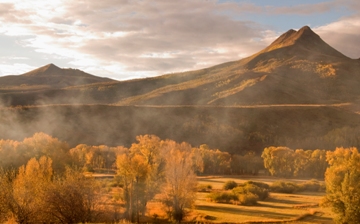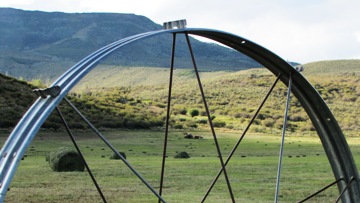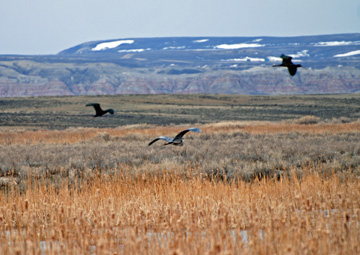Conservation Easements: the Good, the Bad and the Paperwork
By: Amos S. Eno
Posted on:02/25/2011 Updated:04/29/2012A true story of what went on behind the scenes over 8 years to execute easements on the Salisbury-O’Toole Ladder Ranch in Colorado and Wyoming
Even in this age of instant gratification, some of the best things in life still take time. “It was unbelievable,” says Sharon Salisbury O’Toole of the Ladder Ranch in Colorado and Wyoming. “Completing our 2800 acres of ranch easements this past January 14th took us something like eight years from the time we first began talking to land trusts.”
“We spoke with six different land trusts, and ultimately we chose to work with The Nature Conservancy in Wyoming and the Colorado Cattlemen’s Agricultural Land Trust in Colorado.
“We had to execute seven easements to cover all our mountain ranch lands, since not every parcel was contiguous, and raising the necessary funds took time. It also helped with taxes, since the IRS treats the sale of conservation easements as a real estate sale. We spread the easement closings out over three years.

“The lands we put under easement are absolutely the high value ‘trophy ranch’ type landscapes with cottonwoods, sage grouse habitat, and live and ephemeral streams. The Ladder Ranch easements were sold, not donated. Our hearts were in it for conservation, but we flat couldn’t afford to donate the value of the easements. Our lenders would not have gone along with it either, since it would devalue their collateral.”
Educating Banks about Conservation Easements
“You might be surprised to hear that banks are very leery of easements,” Sharon continues, “They seem to have a lot of bad information. They thought easements would restrict all kinds of uses.” An easement is, after all, simply a contract. It is a negotiation, within reason.
“The banks didn’t realize how flexible easement contracts can be. Our goal was to prevent development (one of the criteria to qualify for easement funds), but our easements are very ag friendly. No concentrated feedlots, but they do allow a dditions like a roping arena or calving shed. We tried to leave flexibility for the future. For example, we reserved the right to farm some areas and to generate power from hydro or other sources because eventually we’d like to be off the grid.”
dditions like a roping arena or calving shed. We tried to leave flexibility for the future. For example, we reserved the right to farm some areas and to generate power from hydro or other sources because eventually we’d like to be off the grid.”
After six or seven years of working to find the right partners who could raise the right amount of funding, the O’Tooles finally had two good working relationships. But in the meantime, their bank had failed. “So we ended up with a different lender! We had to get our lender’s consent all over again, since they must agree to honor the easement even in the event of foreclosure.”
There are Red Tails, and then there is Red Tape
One salient characteristic of the easement process stands out to Sharon: “The paperwork involved! You have to get an appraiser that specializes in easements, and there’s not that many of them. In both Wyoming and Colorado you need a baseline report, another specialty, which documents the condition of the property within at most two months of closing. The upside of that was it made me determined to clean up some of our sheds when I knew someone was coming to look at them!
“We worked with Matt Tobler of Blue Mountain Environmental out of Fort Collins for the baseline reports and the environmental assessments. These reports catalogued existing conditions, including fences, ditches, vegetation, and minerals. We owned our Wyoming minerals and they were not leased, so we retained ownership of mineral rights, and restricted surface disturbance. This is a fairly unusual situation.
“In other places we had to work out split-estate issues. CCALT handles the mineral issues with a template agreement that must be negotiated with any energy company that can develop subsurface mineral rights. This is important to the land trust because once they hold the easement, their job is to protect it to the extent the law allows.
“After all that, there’s fundraising. It was easier to raise funds in Colorado because they have GOCO (lottery) funding set aside for conservation, including easements. They also have tax credits, but that’s a pretty difficult process too because there has been abuse. We also had support from Routt County, Colorado, the Wyoming Wildlife Trust Fund, the Doris Duke Foundation, the Elk Foundation, and others, especially The Nature Conservancy.”
Was It Worth It?
“Was it worth it? Yes, whatever happens in the future, the landscape of our ranch will stay intact. It satisfied our values  and our land ethic to do that, and we hope to keep it in the family. The money we received really helped us financially because agriculture is a tough go. It allowed us to retire debt on the ranch mortgage and have something more financially viable for our kids than what we had before.”
and our land ethic to do that, and we hope to keep it in the family. The money we received really helped us financially because agriculture is a tough go. It allowed us to retire debt on the ranch mortgage and have something more financially viable for our kids than what we had before.”
So, an easement adds up to estate planning, landscape protection, and a financial boost, all rolled into one. But, Sharon says, beware. “We worked with great people and made some lifelong friends, but anyone embarking on an easement should not expect it to happen quickly or easily!”
The O’Tooles are now concentrating on working with neighbors nearby to put some of their acreage under easement. Their vision is to see as much of the private land in the Little Snake River Valley protected as is reasonably possible. That’s an impressive ending to the story of the O’Toole easement and a great beginning for the Valley.
Feedback
re: Conservation Easements: the Good, the Bad and the PaperworkBy: Richard H. Day on: 04/29/2012These folks had the tenacity to follow thru and take care of the land you are borrowing from the future. The next generation(s) will say thank you and I do too. Dang, looks my bucket list of places to go see is expanding. We may be in touch,Sharon Salisbury O'toole.
re: Conservation Easements: the Good, the Bad and the Paperwork
By: leslie on: 04/29/2012
It seems all these land conservation programs are being done in every county. Exactly how much land do the environmental organizations want? I believe the USA has like 7% developed which still leaves alot of available land.
 Sign In
Sign In
 Sign In
Sign In
